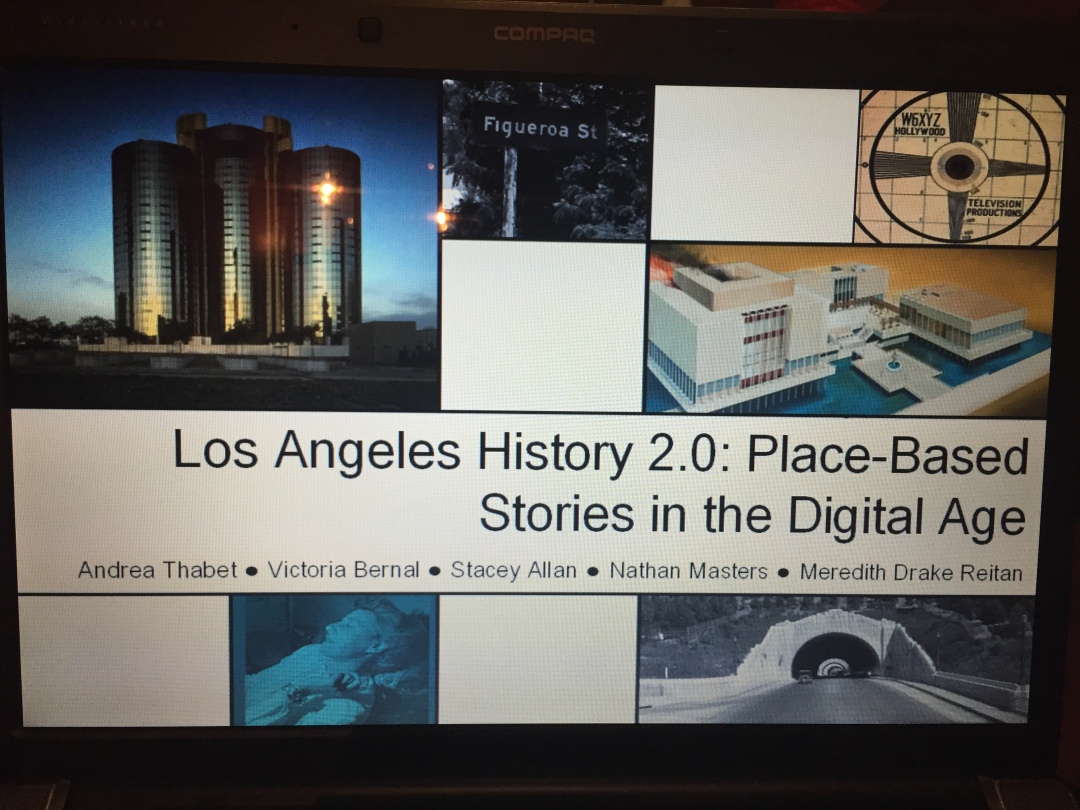 Last November I attended my first Society for American City and Regional Planning History (SACRPH) Conference, and I walked away with one conclusion: everybody loves L.A.
Last November I attended my first Society for American City and Regional Planning History (SACRPH) Conference, and I walked away with one conclusion: everybody loves L.A.
Now, I already knew how great Los Angeles is, but it was both refreshing and exciting to hear that sentiment over and over from visitors.
The conference featured numerous panels that discussed LA’s long and complex history of urban planning, housing, social justice, and the built environment, among other things. My friend and historian extraordinaire Becky Nicolaides appeared on one of the most well-attended panels, Complicating Suburbia, and you can learn more about her views on her excellent blog. I also got to share my experiences on blogging about Los Angeles on the panel LA HISTORY 2.0: PLACE BASED STORIES IN THE DIGITAL AGE, which also featured some of my favorite writers and bloggers: Meredith Drake Reitan, Nathan Masters, Victoria Bernal (founder of the LAhistory twitter handle), and Stacey Allan (Executive Editor of East of Borneo). Our roundtable generated a vibrant discussion about digital media, history, and the challenges and benefits of navigating local history in the cyber world.

As much as I enjoyed the panels I attended, what I enjoyed most were the conversations and connections made outside the conference hotel walls–during walking tours, and off-site panels and receptions. These opportunities showcased the vibrant and varied citizenry, beautiful historic buildings, sunny skies, and rich history of a city too often seen as lacking any planning, any history, or any civic engagement. I also met so many fabulous scholars and practitioners. I got to have thoughtful discussions with them about planning, urban history, and the future of the built environment. I think my favorite moment was during Meredith’s walking tour, when a well-established historian, whose books I read in grad school, turned to me for answers about the some of the downtown buildings and neighborhoods. Yes, I was a little starstruck, but I was also thrilled to share my knowledge, and seize this moment to change the way a fellow historian viewed this magnificent city. What could be better?
Published by Andrea Thabet, Ph.D.
Dr. Andrea Thabet is a historian, writer, researcher, and historic preservation consultant specializing in Los Angeles, urban, and public history. She is currently a Lecturer in American History at Caltech, where she teaches courses on the Civil Rights Movement, and America in the 20th century. She also co-coordinates an urban history seminar series, the LA History & Metro Studies Group, for the Huntington-USC Institute on California and the West. Dr. Thabet holds an M.A. and a Ph.D. in U.S. History from UC Santa Barbara, and a B.A. in History with an Art History minor from Loyola Marymount University. Prior to earning her PhD, she worked as a Curatorial Assistant at the Skirball Cultural Center and Museum in Los Angeles and at the Norton Simon Museum in Pasadena. She has consulted on a number of historic preservation projects, which include a successful Historic-Cultural Monument nomination for the Hawk House designed by Harwell Hamilton Harris (2019), and research and writing about Civic Center Branch Administrative Centers for Survey LA, a city-wide project conducted by L.A.’s Office of Historic Resources.
Dr. Thabet’s published works on Los Angeles and urban history have appeared in both academic and popular journals, in print and digital formats. Her article, “‘From Sagebrush to Symphony’: Negotiating the Hollywood Bowl and the Future of Los Angeles, 1918-1926,” appeared in the Pacific Historical Review in Fall 2020. She also authored the report “Space to Lead: A Century of Civic Leadership in Los Angeles” for Future of Cities: Los Angeles, with Shawn Landres and William Deverell. In June 2020, Dr. Thabet was awarded a fellowship by Friends of Residential Treasures: Los Angeles (FORT:LA) for an interdisciplinary research collaboration with Jenna Snow, titled: “A Women’s Project: Mary Louise Schmidt and the 1936 California House and Garden Exhibition.” The FORT Trail Map launches in March 2023 and will be featured for women’s history month in a number of venues. She is also completing a book manuscript, “Culture as Urban Renewal: Remaking Public Space in Postwar Los Angeles” which examines the critical role cultural and leisure spaces played in shaping the built environment and urban economy of Los Angeles through federal and local urban renewal policy after World War II.
View all posts by Andrea Thabet, Ph.D.
 Last November I attended my first Society for American City and Regional Planning History (SACRPH) Conference, and I walked away with one conclusion: everybody loves L.A.
Last November I attended my first Society for American City and Regional Planning History (SACRPH) Conference, and I walked away with one conclusion: everybody loves L.A.